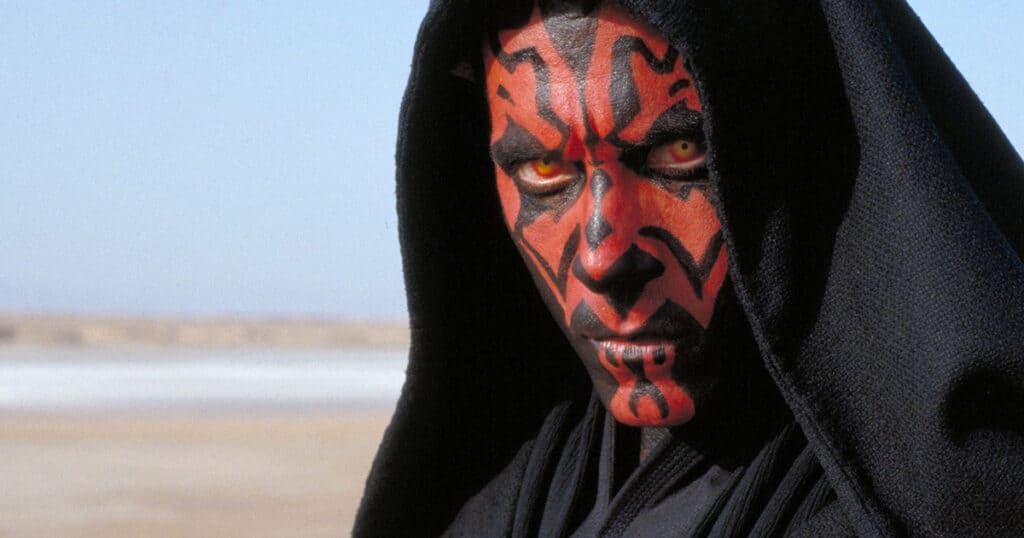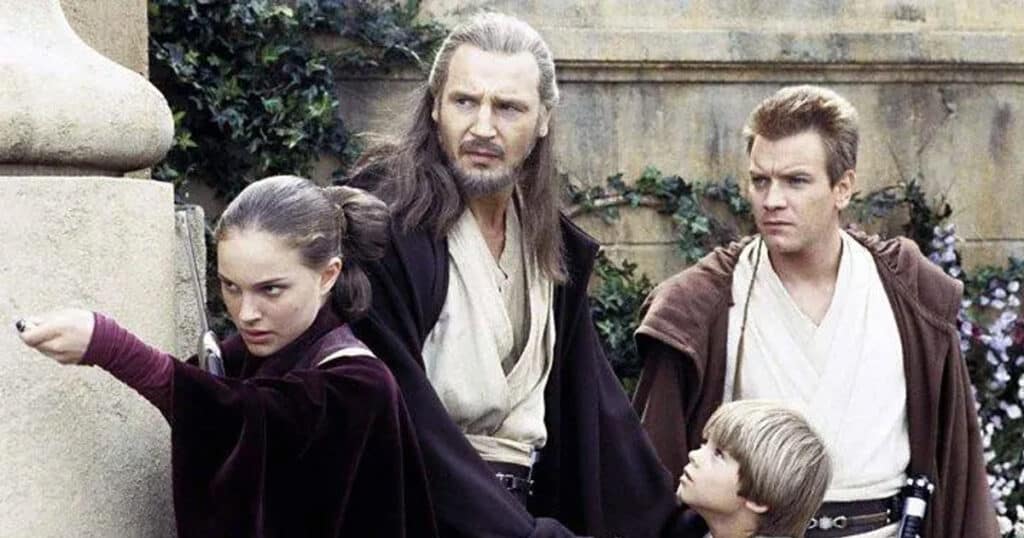
It’s a bit hard to believe now, but once upon a time… a new Star Wars movie coming out was a huge deal. Nowadays, thanks to several movies and an onslaught of TV shows, the Star Wars brand is omnipresent, and not going anywhere anytime soon. But after the 1983 release of Return of the Jedi, there was a Death Star-sized void in the Star Wars galaxy, one that seemed like it would never be filled. When it became obvious in the mid-90s that George Lucas intended to bring his long rumored prequel trilogy to life, there was no doubt movie fans young and old felt like the Force was strong with us, maybe more so than ever before.
The Phantom Menace was to be the first of the three, and in 1999 it entered our world as perhaps the most highly-anticipated movie ever released. This thing came loaded with expectations – expectations that might’ve been impossible to meet. But most people just wanted to be back in that far away galaxy, revisiting familiar characters and worlds while acquainting ourselves with brand new ones. A new Star Wars movie – could you believe it?! And though it would be telling a tale that many of us already knew – at least, thought we knew – there was no denying that the very idea we’d be seeing that iconic crawl on a big screen, accompanied by that gloriously loud boom of John Williams’ theme, was tremendously exciting, prequel or not. Hell, the word prequel itself was something of a novelty, not nearly as commonplace as it is now.
And if we were indeed going back in time, then at least we’d be seeing the origin story of one of cinema’s most memorable villains. We’d heard the name Anakin Skywalker plenty of times, we knew he was Luke’s father and Obi-wan’s apprentice and friend before being turned into the monstrous Darth Vader by the Emperor, but what exactly would that transformation look like? The notion of witnessing Anakin’s devolution from hero to evil henchman was indeed a compelling one, as was the idea of seeing the badass Obi-wan was long before we met him.
I’ll not bore you with the details of this writer’s first time seeing Phantom Menace other than to say I saw it at three in the morning at Manhattan’s legendary Ziegfeld theater opening day – well, opening morning. That should give you an idea of the level of anticipation coursing through these veins. Being in a sold out theater filled with fully-awake fanboys and girls at that ridiculous hour was a genuine treat… For a while…
No friends, I did not like Phantom Menace that first fateful viewing. Nor did I like it the second, or the third time. We’re not going to dwell on the past, just consider it some added context.
Because recently I revisited Episode One for the first time in a long while for the purposes of this “Star Wars Revisited” series, and what better reason? As was the case with the original trilogy, it’s nearly-impossible to watch the film with a set of “quote unquote” fresh eyes while shoving aside all prejudices and grievances, but it deserves as fair a shot at reevaluation as any movie out there, especially considering it’s arguably the most divisive movie in the franchise. Alright, maybe it’s tied with The Last Jedi on that front… So does “The Phantom Menace” look a little different with all those pesky expectations out of the conversation?
Well, here’s the deal. Phantom Menace is still a tough pill to swallow. Scene after scene brings the hope that George Lucas will get the movie on track, get some juvenile humor and caricatures out of his system early, deliver a narrative that brings more to the table than boring bureaucracy and standard getting-to-know-you character introductions. But he never does. The movie is meant to a table-setter, there’s no doubt about that, with Lucas setting the stage for dire future events like the unraveling of the Republic and the extermination of the Jedis – not to mention Anakin’s tortured embrace of the dark side.
But at almost every turn, Phantom Menace is a stiff, unexciting affair, filled with actors who look like they’re trying hard to find inspiration in situations they seem uncomfortable in. When the movie comes to life, it’s because of elaborate visual effects, not because characters we love are doing things we have a vested interest in. The original Star Wars movies are so unique in how they combine eye-popping spectacle with humor, heart, and wonderful personal moments, major and minor. The Phantom Menace never seems to have a beating heart, and when it strives for the big emotional beats that truly grab the audience, it flops, usually thanks to some dodgy acting, inane dialogue and uninspired directing.
This was George Lucas’ first directorial effort since the original Star Wars came out in 1977. We know he was always very closely involved with most of his Lucasfilm Productions, but returning to the director’s chair after a twenty-year hiatus clearly has its challenges. Right off the bat, Lucas shows rust, opening with sequences that look like they were designed to show off CG production design as opposed to involving us in story. There’s a boring formality to the way he composes shots early and often, and you can’t help but blame his over-reliance on shooting in front of green-screen stages for that. Of course, now we know it’s very possible to rely on CGI and green-screens and still deliver a well-directed picture, but Lucas doesn’t seem to have any interest in composing an engaging image within the frame. He’s going to let the wizards at ILM do all the heavy lifting, and the movie’s small handful of stimulating sequences feel as though they were handled by the second unit.
But the director also needs to be in charge of his actors, and he has trouble in that department too… Even during his New Hope days, Lucas wasn’t known as an actor-friendly director, yet he gets marvelous performances from pretty much all involved in that film, and if you take a look at his previous flick, American Graffiti, there’s further proof of a genuine talent with a knack for getting the best out of his ensemble. Sadly, the performances in Phantom Menace are adequate at best, thoroughly unimpressive at worst. That goes for humans and aliens alike.
Liam Neeson and Ewan McGregor are naturally charismatic actors, and that natural screen presence goes a long way here, but Neeson often looks like he has very little investment in what’s going on, while McGregor tries gamely to boost up an underwritten role. Natalie Portman too seems no match for Lucas’ humdrum dialogue and indifferent direction. Even Sam Jackson is slightly off, frequently looking perplexed by his assignment even though we know he genuinely coveted the opportunity to play a Jedi.

The most human performance probably comes from Ian McDiarmid, who appears pleased as punch to be back in action as Palpatine – here depicted as an amiable politician who effectively hides a very dark side. McDiarmid has some fun with the role and consistently brightens up the screen when he’s around, which isn’t often enough. Also effective is Pernilla August as Anakin’s somber mother; if Lucas is able to wring any actual drama out of the sad situation Anakin and Shmi are in, it’s thanks to August’s heartfelt performance.
And as for Jake Lloyd… Look, we’re not here to pile on him. No one should be mad at Lloyd for his performance; playing a young Anakin Skywalker was going to be a challenge for any young actor, and it’s quite obvious early on that Lloyd isn’t up to the task. Again, the blame must be squarely on Lucas’ shoulders for casting Lloyd in lieu of someone else who might bring some spirit to the part. This is young Darth Vader we’re talking about here, and even though we meet him as an innocent child, there should at least be a little bit of an edge to him – especially considering the Jedi council’s wariness surrounding his apprenticeship. Watching him, all we can think is: “This guy is gonna be Darth Vader?”
We’re also not going to pile on Jar Jar Binks – not too much, anyway. He’s received twenty-plus years of relentless bashing and that’s been plenty. But for the purposes of this Revisit, let’s not mince words: Jar Jar is a ridiculously ill-advised and unwelcome element in Episode One. To say this movie is often in dire need of some comic relief in it is to understate matters, but Jar Jar is not the solution. He makes the silliness of C3PO look positively dignified, although if we can give any kind of compliment to the legacy of Jar Jar, it’s that you can’t deny Ahmed Best – the actor playing him – is bringing all the energy he can muster to the forefront. Lucas was always adamant that Jar Jar and his shenanigans were aimed at a younger audience, and maybe he does indeed work for that demographic, but you can’t convince me this was the best we could do.)
And the less said about Boss Nass, the better.

These characters are thrust together in a story that takes a painfully long time to generate any kind of intrigue. The pressing issue at hand has to do with the Trade Federation, its blockade of Naboo, and its conspiracy with the dreaded Darth Sidius, who is using them as pawns in his quest to control the galaxy. As mentioned already, this movie is meant as a table-setter for the rest of the trilogy, but the Trade Federation storyline is a non-starter; even if it’s necessary in the grand scheme of things, it completely bogs the movie down whenever it’s the focus. Add to that, the Trade Federation characters, the Neimoidians, are thoroughly dismal creations – we take them no more seriously than we do Jar Jar, and they’re supposed to be the main antagonists of the piece.
But that brings us to another looming issue for Phantom Menace. There really are no villains to root against. The Trade Federation obviously can’t fit the bill, and Darth Sidius is more of a vague threat than tangible bad guy. That leaves us with Darth Maul, who received so much hype prior to the film’s release. The promise of Darth Maul being a flashy new baddie in the Star Wars universe was very enticing, but the movie barely utilizes him at all. He’s in one fairly unexceptional dust-up with Qui-Gon in the middle of the film, and then he gets his big moment in the third act with a rousing lightsaber duel against the Jedis. The movie’s best sequence, it brings life to Phantom Menace at a critical time – though of course it’s frustratingly intercut with the bumblings of the Gungans and Anakin alike. Just when we’re getting used to Darth Maul as an intimidating foe, he leaves the premises in pieces, and we bid adieu to the most captivating character in the film. The fact that his death hits harder than Qui-Gon’s really tells you something.
The third act has another saving grace, and that’s John Williams’ “Duel of the Fates,” a great track that still maintains immense power. Williams’ score for Phantom Menace overall is far from his best, but “Duel of the Fates” just about makes up for it. He would go on to do much more memorable work in the next two prequels, however, once again becoming one of the main MVPs for the “Star Wars” series.
In purely visual terms, Phantom Menace brings some superficial pleasures; Naboo – above and below the surface – is a lovely place to look at, and ILM’s artists frequently give us enjoyable sights such as the frightful underwater monsters Qui-gon and Obi-wan encounter. The pod race is also an entertaining set piece, even if it does feel like it’s just filling time and giving us a sorely-needed action sequence in a movie that, until that point, hasn’t been very thrilling.
When it’s all over, and the droid army has been temporarily defeated and Boss Nass holds up that glowing orb thing, there’s a surreal feeling that comes over those of us who’ve been disappointed by the experience. For better or worse, this is how the prequel trilogy begins: it has established the core of our main protagonists moving forward, introduced a lot of excitable cartoon characters, and made us privy to more otherworldly politicking than was expected. There’s no doubt that we can only go upward from here… Right?
To be fair, several of our viewers will disagree with the overall tenor of this review, and that’s understandable. Through the years I’ve met plenty of Star Wars fans who enjoy – or at the very least, accept – The Phantom Menace. No one wanted it to be great some twenty-plus years ago more than this writer, just as I wish it contained a number of happy surprises and pleasures upon a revisit. It does not, not for me.
But it’s not a bad thing that the movie has its fervent supporters. A generation of geeks grew up with the prequel trilogy as their focal point in all things Star Wars, folks who couldn’t imagine a world without Phantom Menace and will absolutely go to bat for the film time and time again. Love it or hate it, Phantom Menace is an integral part of this very special corner of the galaxy. It’s a part of who we are, and you can’t take that away from it…
Now send in the clones.
Originally published at https://www.joblo.com/the-phantom-menace-revisited/
The post Is Star Wars: The Phantom Menace better than you remember? first appeared on Digital Gossips.
Entertainment - Digital Gossips originally published at Entertainment - Digital Gossips









